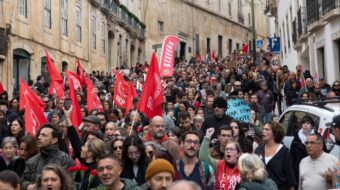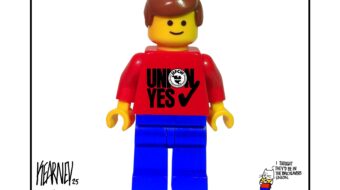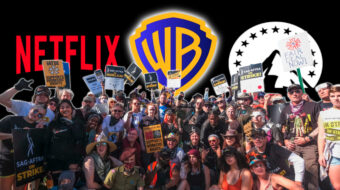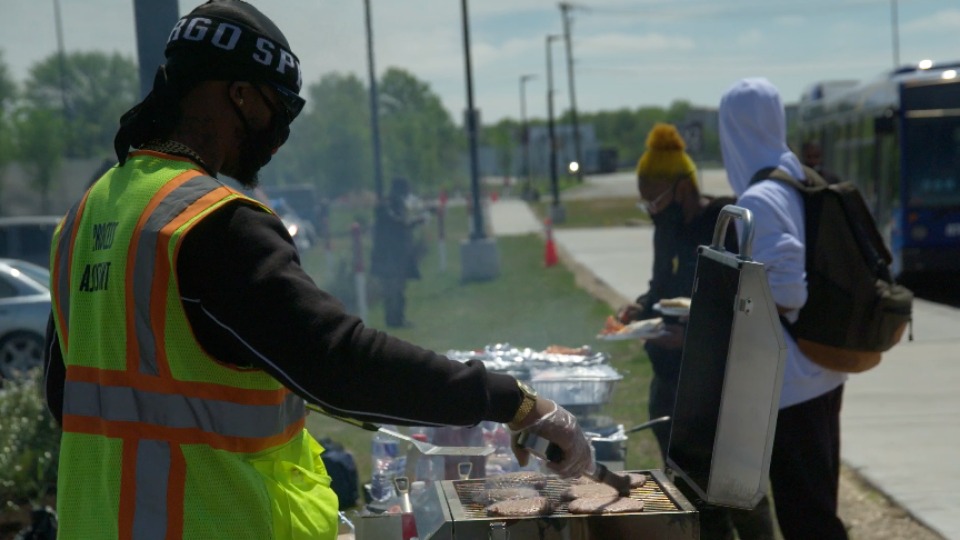
STATEN ISLAND, N.Y.—It’s not unique in the history of workers, but the Amazon workers at the retail monster’s Staten Island fulfillment center and four warehouses are trying something relatively rare: Forming their own independent union and organizing from the bottom up.
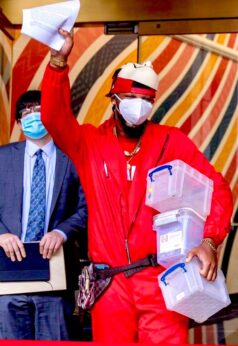
Started by Chris Smalls and Derrick Palmer, the union, found at AmazonLaborUnion.org and @AmazonLabor on Twitter, is “a worker-led movement to put power back in the hands of Amazon employees,” its mission statement says.
“In the midst of COVID-19, it’s become more obvious than ever the company values profits over people and will consistently make decisions that harm workers if it means saving money,” the union explains on its website.
“The goal and purpose of the Amazon Labor Union is to change the relationship between the company and its workers so we can negotiate a better, safer, and more equitable workplace.”
In its press release announcing it filed more than 2,000 union recognition election cards with the National Labor Relations Board’s Brooklyn regional office on Oct. 25, ALU added: “Workers are demanding Amazon stop their union-busting practices and allow workers to use their rights to organize towards collective bargaining without interference.
“We intend to fight for higher wages, job security, safer working conditions, paid time off, better medical leave options, and longer breaks. We also want to bring back monthly bonuses for attendance and productivity and become shareholders with the company on Day 1, which both existed back in 2018.”
Amazon illegally fired Smalls last year for organizing a lunchtime walkout from the main Staten Island facility, JFK8, over lack of anti-coronavirus protection. New York Attorney General Letitia “Tish” James is investigating whether Amazon broke state labor law, and Smalls filed suit against Amazon in federal court in Brooklyn a year ago for breaking other laws.
If the demands were the central point, the Amazon Labor Union would be running a familiar organizing drive, as the Retail, Wholesale, and Department Store Union did at Amazon’s giant warehouse in Bessemer, Ala.—a drive that inspired Smalls and colleague Derrick Palmer to start ALU and their campaign. Due to Amazon’s labor law-breaking, RWDSU failed.
There, workers decided to organize, then sought out a union to organize them. Where the Amazon Staten Island drive differs from a traditional effort is that the workers, rather than approaching the unions and seeking sponsorship and organizing help, are doing it on their own—they’ve set up their own independent union.
Bessemer lessons
But RWDSU’s experience brought them other knowledge. “The lesson that I would say we learned is to be more interactive with the workers,” Palmer told NBC. “With Amazon, you know they like to spend a lot of money on union-busting campaigns. So if we’re not out there every day, if we’re not consistent, then Amazon can capitalize on that.”
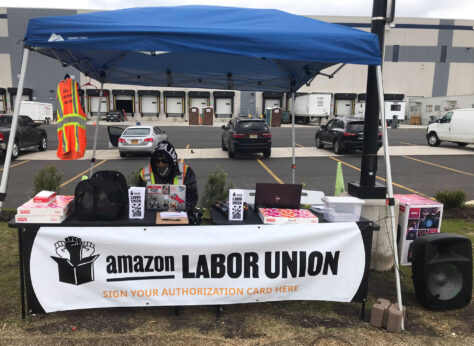
“The established unions have expertise, money, and resources. But Amazon is a different animal,” Smalls told Reuters. “There is no playbook for unionizing Amazon, you just have to earn the trust of workers. It’s really just us on the ground having face-to-face conversations and building relationships.”
Building relationships is, of course, key to organizing success. The difference, one Rutgers labor law professor told Reuters, is that workers going it alone robs Amazon of a key weapon it used to beat the workers in Bessemer. There are no “union bosses” and few outside issues, or personalities, it can attack.
“With union protection, Amazon would no longer be able to fire employees without just cause,” ALU’s website posting elaborates. “Workers deserve to have an advocate in the event of wrongful termination or mistreatment. HR only exists at Amazon to protect the company, not the workers.
“The only people who will advocate for our rights, interests, and protection are our fellow workers.”
The Amazon Labor Union’s six-month bottom-up organizing drive emphasizes wages, working conditions, safety, and health—especially against the pandemic—and a voice on the job as key issues. The wage difference alone is $11,000 yearly per worker, in favor of unionized workers, ALU says.
The working conditions inside Amazon’s four Staten Island facilities are so bad that a key draw for the union has been a daily barbecue of hotdogs, hamburgers, baked ziti, and seafood mac and cheese in ALU’s tent outside and across the street from JFK8.
The union’s six-minute video on its website explains why: “The food inside there is horrible,” one worker said. Amazon’s response: A barbed-wire fence surrounding that fulfillment center.
Other bottom-up models
There are other examples of such bottom-up organizing, but they’re infrequent. The most obvious examples are worker centers, which started in Chicago and Los Angeles and spread elsewhere. Another is an entire AFL-CIO affiliate, the National Domestic Workers Alliance.
The centers are places workers, especially foreign-born workers and people of color, can go to organize themselves—again without a regular union involved. They may later go union, to benefit from union resources and structures. That’s happened in Minnesota.
“As early innovators of an intersectional approach to organizing, the worker center field positioned economic justice as fundamentally linked to racial and gender justice,” Laine Romero-Alston and Sarita Gupta recently wrote in The American Prospect.
“Worker center leaders, often supported by academic partners, developed sophisticated sector-specific strategies based on research and deep industry knowledge. Both organically and intentionally, they focused their organizing on sectors of the economy that were growing, where large numbers of women, immigrants, and workers of color were employed, and where the traditional frameworks and approaches to organizing either weren’t working or weren’t a focus of labor unions.”
That’s changed, to some extent. “In the past decade, worker centers have forged and strengthened partnerships with unions, some of which had previously viewed the centers skeptically,” they add.
Child care workers, aided by union lobbying in 12 states—notably Service Employees’ lobbying in California and Illinois—won the right to organize to some degree, even though federal labor law says they can’t. State laws are another matter, and SEIU and the workers won those laws in blue-state legislatures.
“Family childcare providers have had some success organizing under a different model,” Harvard’s OnLabor blog reported. “Without clear ‘employee’ status” under federal labor law, “these home-based workers, who are typically regulated and receive income through subsidies provided by the state, relied on state legislation and executive orders to grant them collective bargaining rights with the state as employer.”
And The Guardian reported in March on a new restaurant, Understory, a worker-led collaborative and cooperative, that opened in Oakland, Calif., right in the midst of the pandemic. “We see Understory as a way to create and uplift the labor structure that we want to see,” Diana Wu, who helped organize the collective, said. “It is an ambitious goal, given that the food industry operates on such small margins.
“But we also know [the industry] is built on so many problematic labor practices and sourcing practices—so we are trying to have an intentional intervention there.”
At least one union, Unite Here, adopted bottom-up organizing, almost three decades ago, University of New Hampshire economist Rick Hurd wrote in Building The Ranks, a 1986 article for Cornell’s Institute of Labor and Industrial Relations.
But the difference between that drive and Amazon is that while the workers started and controlled the drive, they then affiliated with Unite Here Local 34 in New Haven, Conn., to win the recognition vote at Yale University. The union rep who gave them the information and training was the business agent for neighboring Local 35, John Wilhelm, later Unite Here’s president.
As then-Unite Here Organizing Director Vincent “Sirabella sees it, the organizer should build from the bottom up, helping workers recognize their own abilities and potential. For a union to succeed, it must belong to the workers—the members must be provided with the information and training they need and then given the opportunity to carry the burden.
“There was no announcement, and no literature was distributed. All contacts were face to face, often in the worker’s own home, and the message was consistent: ‘A union needs to be built here. If you agree, it’s up to you to get to work. It won’t be easy. But you can change things if you stick together.’ According to the Unite Here philosophy, every member of the union is an organizer. The paid organizer’s job is to facilitate the work of the rank and file.”



